Primary Directions Classic

What is Primary Direction? - we ask the Astrologer.
The Master shows on model of heavenly sphere which holds in a hand, and speaks:
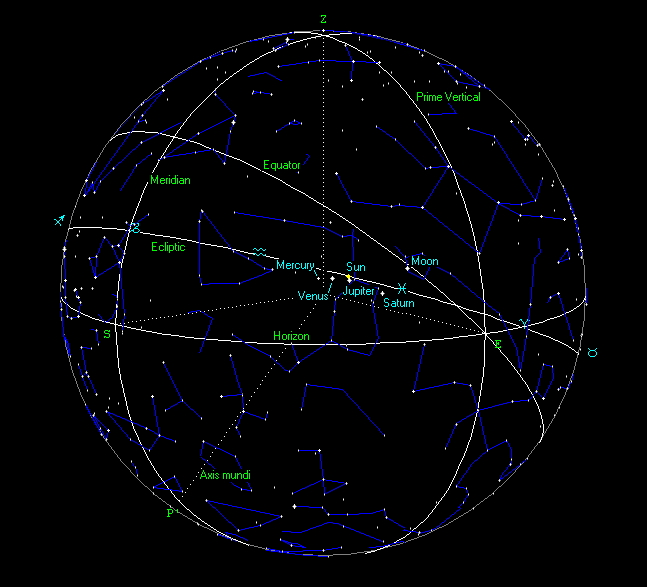
Here the heavenly sphere in horizontal system of coordinates, a celestial globe,
outside view.
This is a sky for birth of Jean Baptiste Morin de Villefranche,
Morinus, Johannes; 23.02.1656; 8:30; +0:18:52; Beujolais, France; 45N59; 4E43; M;;
We see points: south, east, zenith.
And also circles: horizon, prime vertical, meridian. ecliptic, equator.
We see stars and constellations.
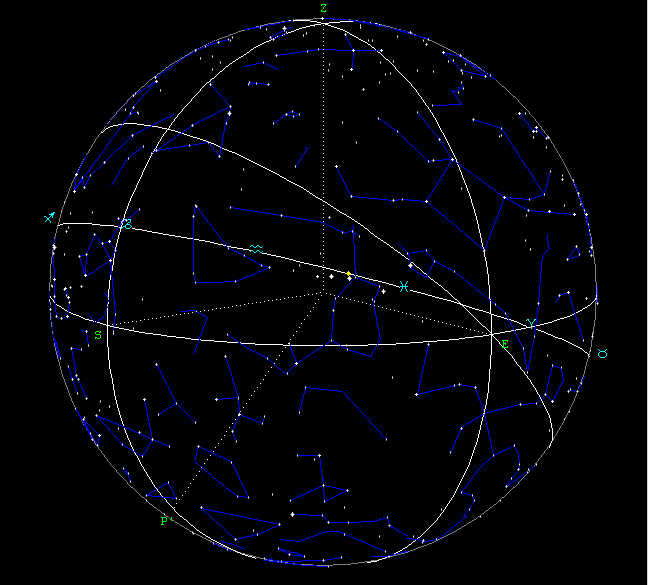
We see the constant daily motion of heavenly sphere caused by rotation of the Earth around it's axis, "axis mundi", it is so-called primary motion. While this movement the planets rises, sets, culminates and anti-culminates.
Now lets fix position of planets (natal) on heavenly sphere and consider, how directing planets will move concerning natal (many methods of the astrological forecast are based on this approach).
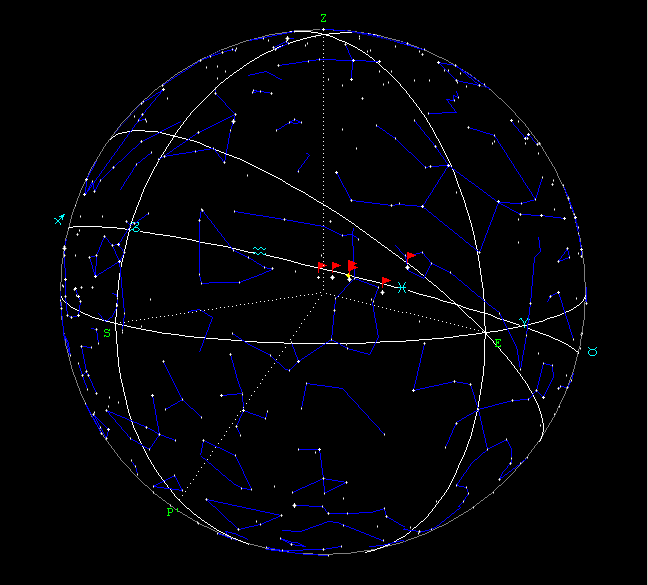
The directing planets are marked here by red flags. It is possible to compare, for example, coordinates of planets in ecliptic, then equality of eclictical coordinates of natal and directing planets will be considered as their conjunction. But thus it can appear that planets have an equal longitude, but are in different houses, for example, one over horizon (in 12th house), another under horizon (in the 1st house).
Classical variant is other: positions of planets are considered relatively house cusps, and in so-called quadrant systems of houses in which the horizon is first and seventh house, the tenth and the fourth is a meridian. The system of Placidian houses, for example, concerns such systems.
Let's leave on heavenly sphere only Saturn and Mercury. Then for some moment of time we will get this picture:
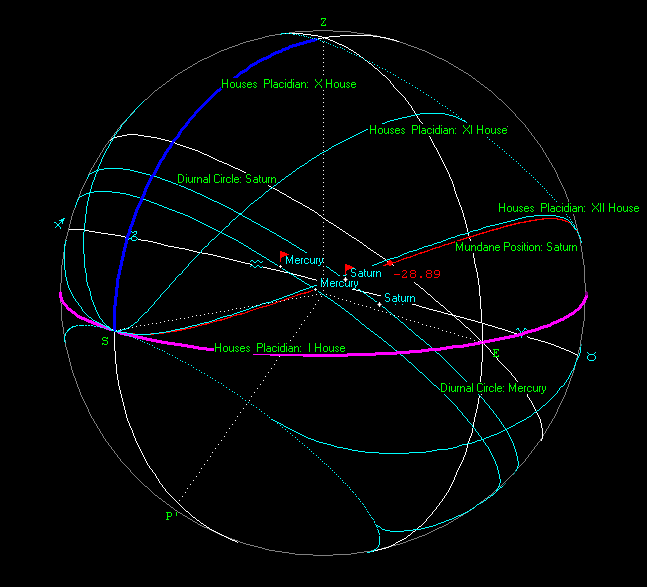
Here are shown:
- Houses of Placidus as it looks on heavenly sphere, instead of on a flat chart,
- Daily parallels of Saturn and Mercury: circles on which these planets make
an apparent motion on heavenly sphere because of rotation of the Earth,,
- A line of mundane projection of Saturn, coinciding the Mercury
with the same line.
The mundane projection of a planet is a line passing through a planet and located proportionally next house cusps. The numerical characteristic of mundane projection of planet is it's mundane position. Equality of mundane positions means conjunction of planets (mundane). In this picture we can see that directing Saturn has come to conjunction with natal Mercury.
What is the forecast by Primary Direction?
Degrees of turn of heavenly sphere are put in conformity with the years
of native's life.
The arch of turn is measured on equator (a right ascension).
Various "keys" ("timings") of direction are thus used, for example,
a key of Ptolemy are: 1 degree of right ascension corresponds to 1 year.
For example, directing Saturn has passed before conjunction with natal Mercury
of 9 degrees and 25 minutes, it corresponds to 9 years and 5 months of native's life.
I.e. for this time the event corresponded with symbolism of these planets
is predicted for this chart.
How ZET do that?
Check up, whether is available the "Primary Direction" type in the list of types of charts (the "Chart Types" window). If isn't present then open the "Dual Chart Editor" and create this chart type: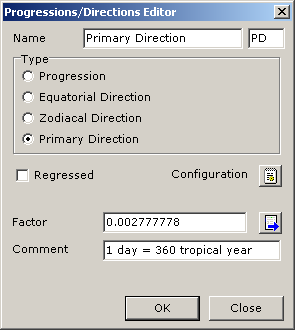
Click "Tables" button, choose "Primary Directions" menu item. You will see:
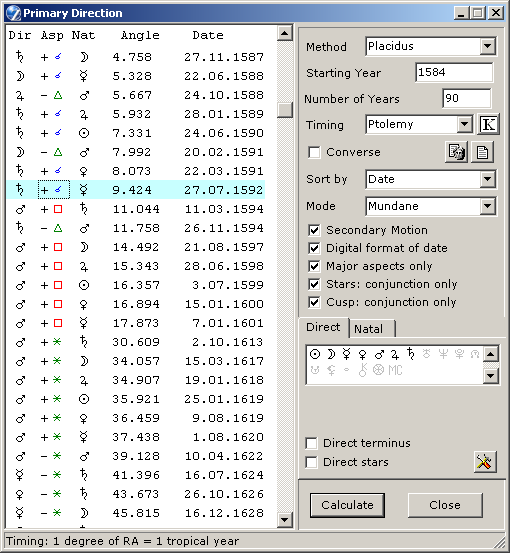
Input appropriate parameters and click "Calculate" button. In the left field there will be a desirable table with the list of aspects of directed planets with natal, arcs of direction which there has passed directed planet to aspect with natal one, and the date corresponding to this arc.
Click by right mouse button to some line of table. Will appears a menu:
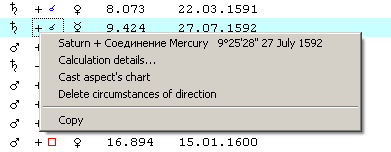
Choose "Cast aspect's chart" menu item. If a "Horoscope Chart" tableau established, you will see about following (do not forgot to cast a dual chart with "Primary Direction" type and switch on a "Mundane aspects" option in a Chart Settings, Aspects, also you may open the "Aspect List" window):
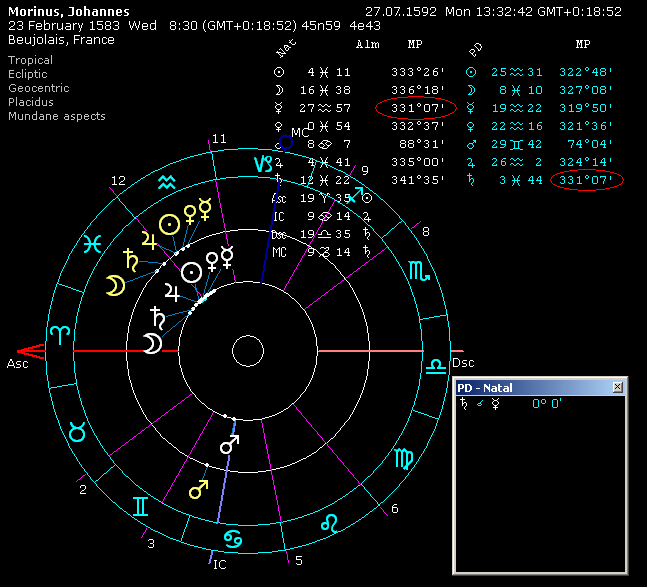
If the "Sky" tableau established, you will see:
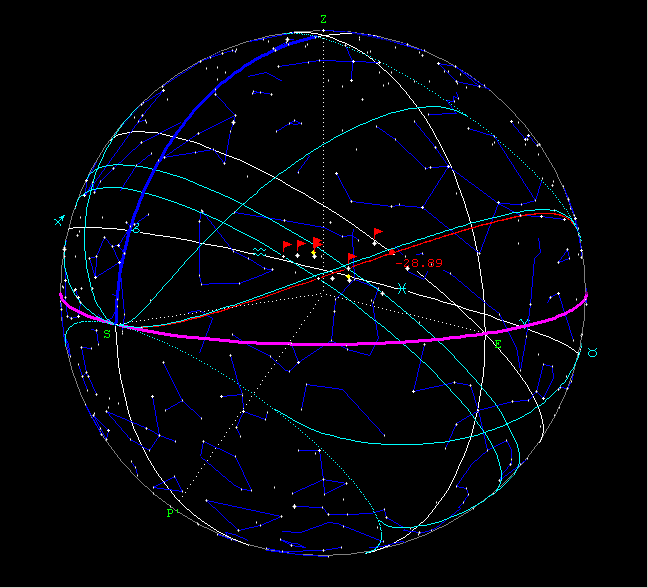
Lines of mundane projections and daily parallels of planets we will name circumstances of direction. To switching-off displaying of these lines choose "Delete circumstances of direction" menu item.
What is "Secondary motion"?
This is own movement of a planet on it orbit around the Sun or the Earth (for the Moon).
The option "Secondary motion" in a "Primary direction" window should be checked. The possibility of switching-off of this option is available only for check of corresponding algorithms of calculation and for comparison with sources, where this motion is not considered.
Secondary motion leads to that an arch of direction for quickly moving planet is reduced. The secondary motion is directed backward of primary one, i.e. secondary motion slows down a planet apparent motion in the sky. This effect is swept most up, naturally, for the Moon.
The example of Bob Makransky
Lets calculate the Primary Direction Classic in ZET 9 with a sample of prince Charls chart, described in a book of Bob Makransky. Primary Directions.

L D RA MD SA MD/SA PMP
Sun 232.42 -18.38 230.01 37.64 114.69 0.32822 119.54
Moon 30.44 11.24 28.48 -16.11 104.47 -0.15419 283.88
Mercury 216.96 -12.16 215.20 22.84 105.71 0.21602 109.44
Venus 196.38 -4.76 195.79 3.42 96.00 0.03566 93.21
Mars 260.95 -24.06 260.07 67.70 124.15 0.54531 139.08
Jupiter 269.89 -23.38 269.87 77.50 122.92 0.63047 146.74
Saturn 155.27 10.92 157.62 -34.74 75.96 -0.45742 48.83
Uranus 89.93 23.65 89.92 -77.56 123.40 -0.62848 326.56
Нептун 194.13 -4.17 193.59 1.22 95.25 0.01281 91.15
Pluto 136.56 23.07 141.48 -50.89 57.62 -0.88316 10.52
Asc 125.50 18.90 127.87 -115.50 -115.50 1. 0.
MC 13.44 5.31 12.37 0. 96.71 0. 270.
Lets use Placidus house system. In a "Sky sphere" tableau the cusps
of Placidus houses looks as:

Z - zenith,
P - axis of mundo (north pole of equator),
E - east point,
N - north point.
Following circles are there:
horizon (E-N),
equator (crosses a horizon in E point),
prime vertical (Z-E),
meridian (Z-P-N).
The line of 1st and 7th house cusps (Asc и Dsc), horizon, displyed by hysgine. 10th and 4th (MC и IC), by blue. Other cusps by light blue.
The geographical latitude circles displied by dotted lines. If the declination of some celestial body are greater, then a geographical latitude of current place, then its position in Placudus are not specified (or specified by any special manner).
The Placidian primary direction based on a concept of objects mundane position
(promissors and significators), i.e. coordinate of object on an equator line.
The mundane position of 1st house cusp always equal 0, 2nd - 30 degrees, 10th - 270 and so on.
It calculated by formula:
MP = (n-1)*30, where n - house number.
The mundane position of celestial body calculates by appropriate formulae,
accordingly its house position.
On a screenshot bottom displyed the Placidian projections of natal Saturn
and directed Moon, and its mundane positiona (red).

There are details of appropriate calculation (by program):
Placidean Direction RAMC: 12.3688 Promissor: Луна RAp: 28.4772 Significator: Сатурн RAs: 157.6241 MPs: 48.8325 SAs 75.9586 MDs -34.7447 Aspect: -120.0000 MPap = MPs + Aspect MPap: -71.1675 RAap: 0.2093 ADap: 14.4683 R: 12.3688 T: -1 V: 1 Arc = RAp - R + T*RAap*(90+V*ADap) Arc: -5.7517 = 5°45' 6"